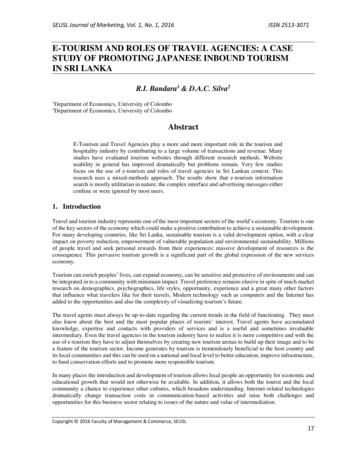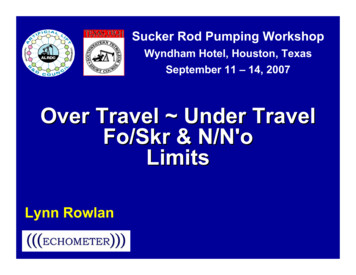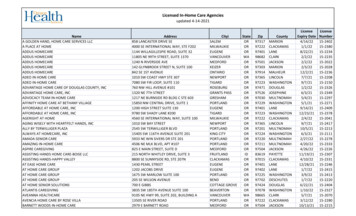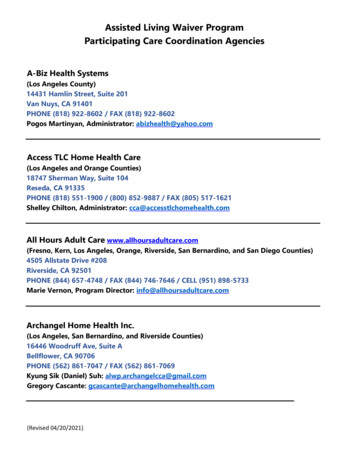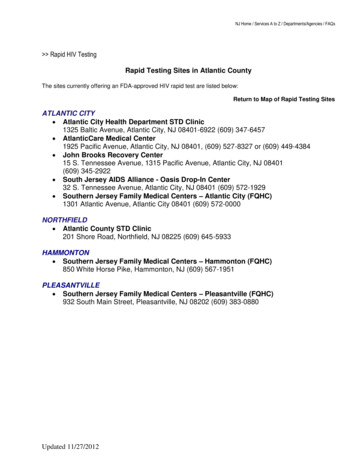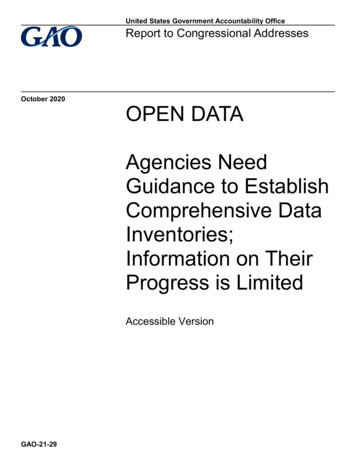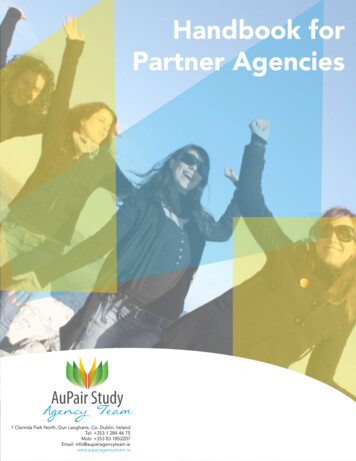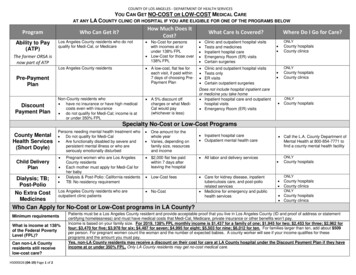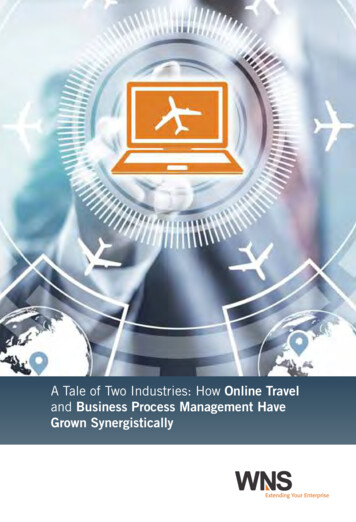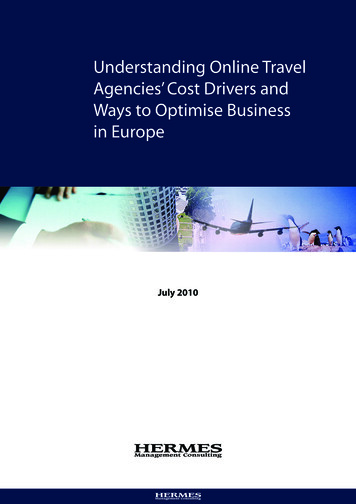
Transcription
Understanding Online TravelAgencies’ Cost Drivers andWays to Optimise Businessin EuropeJuly 2010
Understanding Online Travel Agencies’ Cost Driversand Ways to Optimise Business in EuropeJuly 2010IndexAbstract. . 5Research Methodology. 5Sample. 5Introduction. . 7Market Overview. 7Executive Summary. 10Study Results. 11Average Agency Revenue Structure. 11Average Agency Cost Structure. 16Traditional costing analysis. 16Activity Based Costing Analysis. 18Introduction. 18Marketing & Acquisition. 19Online Search & Booking. 24Offline: Call centre, Fulfillment and Customer support. 26Back Office: Invoice, Collection and Payment Preparation. 28Support Activities. 28Procurement. . 28Technology Management. 29Firm Infrastructure and Human Resources Management. 29Profitability and Productivity Analysis. 30Conclusions and Recommendations. 32Revenue Diversification. 32Cost control in the marketing area. 33Cost control through automation and outsourcing. 34Customer experience enhancement. 35Provider negotiation. 36Better mechanisms for tracking trends and competitive positioning. 36Appendix. 37Methodology - Details. 37About Hermes Management Consulting. 4003
Understanding Online Travel Agencies’ Cost Driversand Ways to Optimise Business in EuropeJuly 2010Understanding Online Travel Agencies’Cost Drivers and Ways to OptimiseBusiness in EuropeAbstractThis White Paper reviews the results of an independent research study of Online Travel Agencies(OTAs) conducted in Europe from November 2008 through to July 2009 by Hermes ManagementConsulting (Hermes). The financial data used in the study is from 2008.The research was commissioned by Amadeus in order to: Better understand average revenue and cost structure of the OTAs Analyse OTAs business models, processes, cost drivers and productivity levels Understand OTAs needs, identifying opportunities to add value and optimise businessA similar Activity-Based Costing (ABC) study was carried out in Scandinavia in 2006. This time thescope was widened to include five OTAs from France, Germany and the Netherlands as well asScandinavia. This innovative study will open windows of opportunity for European Online TravelAgencies. The purpose of this paper is to communicate the results of the research, and offerrecommendations on how OTAs can improve their margins and better meet the needs of theircustomers.Research MethodologyActivity-based costing is used to identify, describe and assign costs to business activities andto report on the operations of OTAs. Since the ABC analysis determines the ‘true’ cost of a productor service, it is more effective at identifying opportunities to improve business processesthan traditional accounting. During the project the financial data of the participating OTAs wasreviewed and their business processes were closely examined, thus allowing the main cost driversto be identified.A detailed explanation of the research methodology is provided in the appendix.SampleThe sample is composed of five mid-ranged OTAs from France, Germany, Sweden, Norway andThe Netherlands (See Chart 1). The OTAs represent a mix of local, regional and pan-Europeanplayers each of which, on average, generates 308,000 tickets per year. A ticket is composed ofapproximately 2.2 air segments.05
Although the participating agencies are mid-sized businesses, they represent a fair picture of theEuropean OTA landscape. Most of the participating OTAs operate in one or two markets, targetingessentially leisure customers.Chart 1OVERVIEW OF PARTICIPATING OTAsOTATickets(‘000)OTA 1264824OTA 2165OTA 3OTA 4OTA 50623157
Understanding Online Travel Agencies’ Cost Driversand Ways to Optimise Business in EuropeJuly 2010IntroductionMarket OverviewThe European travel market is the world’s largest regional travel market in gross bookings,amounting to E238 billion in 2008.Chart 2EVOLUTION OF ONLINE TRAVEL BOOKINGS IN EUROPEIn billion CAGR ’06-’11OnlineOTASupplierweb 14.1%8.6%-5.1%Source: PhoCusWright Europe Online Travel Overview 5th Edition (November 2009)Supplier websites have always had a bigger share of the online market (close to 70% in 2008).However, the Online Travel Agency market is expected to grow more than the supplier side. By2011, OTAs will represent 36% of the total online share. In terms of penetration rate, the onlinemarket in Europe was expected to reach 32% in 2009, some way to go before reaching the USaverage of 38%. However, it is worth mentioning that two European markets, Scandinavia and theUK, have a higher penetration than the US at 45% and 40% respectively, according toPhoCusWright.One of the main characteristics shaping the European online market is its diversity.07
Chart 3LEISURE AND UNMANAGED ONLINE BOOKING PENETRATION BY COUNTRY2009, in %Total bookings(in billion )45.0%ScandinaviaUnited 14.0%13.151.943.048.123.319.2Source: PhoCusWright’s European Online Travel Overview 5th Edition (October 2009); Hermes’ analysisOne of the main differences is market maturity, as each market is in a different phase of its onlinegrowth cycle. The UK (40%) and Scandinavia (45%), thanks to their high internet penetration rates,were the first markets for Online Travel Agencies to establish a presence and are therefore the mostmature. France (30%), Germany (24%), Spain (19%) and Italy (14%) are considered to be the growthmarkets in the region.Another characteristic of the European market versus the US market is the number and typeof players in each market. The European market is made up of approximately 65 players, which isquite fragmented compared with the US, which has no more than 10 players. However, in theUS 99% of the total business is done by the four largest OTAs; in comparison the ‘Big 4’ in Europeonly represent 55.6%.The US ‘Big 4’ generate 38.8 million air bookings on average whereas one of the ‘Big 4’ in Europegenerate 7 Million bookings. In Europe, the average air bookings per player is different by market,averaging out to 770,000 air bookings (approximately 350.000 tickets).08
Understanding Online Travel Agencies’ Cost Driversand Ways to Optimise Business in EuropeJuly 2010Chart 4NUMBER OF ONLINE PLAYERS AND ONLINE BOOKING VOLUME COMPARISON BY COUNTRY2010Number of playersBookings per playerTotal online .7713.37.84.19.37.85.82.550.5Source: Amadeus IT Group; Hermes’ analysisThe role played by OTAs changes considerably according to market dynamics. Each individual markethas different cultural, technological, regulatory, demographic and buying dynamics. These differencescan be seen in the type of products sold by OTAs, and in the way products are displayedand marketed. European OTAs can be segmented in three different groups, ‘global’ such as Expedia,‘regional’ (Opodo) and ‘local’ (GoVoyages in France). The structure of each market varies considerably,some markets are very concentrated and others are fragmented.European Online Travel Agencies have evolved tremendously since they first started their operationsin 1998. They have made huge inroads in technological innovation, content management,consumer shopping experience and operational efficiency, amongst others. They are also beenthe only travel agency segment to show an incredible resilience during economic downturns.However some issues still need to be addressed for European Online Travel Agencies to prosper:(i) Staying competitive: The European online landscape is highly competitive with not only a largenumber of OTAs but also other players such as supplier websites, tour operators, consolidators andoffline travel agencies. Metasearch companies have added to this competitiveness by making pricecomparison very easy. Price has become the only competitive weapon but tends to commoditisetravel products.(ii) Ensuring customer loyalty: As price is the main driver for purchasing travel online, theEuropean consumer is very accustomed to clicking between various websites to search for the bestdeals on their air tickets which is perceived as a commodity by end-consumers. On average aEuropean consumer searches through 4.97 websites (source: PhoCusWright European ConsumerTravel Trends Survey) before making a booking. The only way for Online Travel Agencies to surviveis to stop competing on price and to find other differentiating factors such as content, service,technology etc.(iii) Profitability: This is one of the challenges facing European most mid-sized OTAs. Their marginsare minimal or non-existent: this is due to high costs and low prices they are forced to offer in orderto stay competitive and to the current product mix they offer. A lot of these Online Travel Agenciesare no longer start-ups and are facing pressure from their investors and shareholders to turn aroundthe situation.This white paper will highlight some of these challenges in more detail and will try to proposesustainable long-term solutions to these issues.09
Executive SummaryThe Activity-based costing (ABC) study aims at better understanding mid-sized European OTAs’average revenue and cost structure, as well as their processes and activities. As a result, the ABCanalysis clearly identifies opportunities to add value and optimise business. Here are the resultsfrom five participating OTAs from France, Germany, The Netherlands and Scandinavia.The current situation can be reversed if the following three main challenges are overcome:Revenue diversification: cross selling non-airMost OTAs need to increase their revenue sources and focus on higher margin products. OTAs arestill air centric, with air tickets representing 86% of their gross sales despite delivering a lowmargin of 6.6%. Non-air products generate 12.8% margins but only account for 14% of their grosssales. There is an obvious need to increase the non-air offer (hotel, packages, insurance, cruise etc.)and therefore improving cross-selling from air products, leading to better margins and customerloyalty. Advertising as a new source of revenue should also be considered.Enhanced Customer ExperienceAs conversion rates for the studied OTAs are very low, OTAs need to stand out by offering savvytravellers an experience that will make them want to book more and increase loyalty. Technologyneeds to be adapted to respond quickly to customer deman
However, the Online Travel Agency market is expected to grow more than the supplier side. By 2011, OTAs will represent 36% of the total online share. In terms of penetration rate, the online market in Europe was expected to reach 32% in 2009, some way to go before reaching the US average of 38%. However, it is worth mentioning that two European markets, Scandinavia and theFile Size: 2MBPage Count: 40

